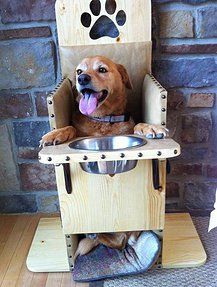What Is Megaesophagus In Dogs? How Dangerous Is It?
08.02.2022.
Unfortunately, dogs can be diagnosed with different disorders. One of them is called megaesophagus. If you are worried about your dog’s health and you think they might have developed this issue, you should probably know a bit more about it. The best thing to do would be to call your vet and schedule an appointment. In the meantime, here’s what our vets would like to tell you about megaesophagus in dogs.
What is the esophagus?
The esophagus is a “tube” that leads the food and liquid from the dog’s mouth to its stomach. It is a muscular tube, and it is a vital part of the dog’s digestive system. We have it too, and humans can develop megaesophagus, just like our beloved pets can.
A healthy esophagus should function like this - the food in the mouth stimulates the nerves, which send signals to the brain. The brain then sends signals that will trigger the swallow reflex. Esophagus also helps keep the stomach content “down.”

What is megaesophagus in dogs?
Megaesophagus is not a single disorder. In fact, it describes several different potential issues your dog might suffer from. It can be defined as a disorder that will affect the dog’s esophagus so that it will lose its motility and shape. The esophagus will widen, which means its ability to move the food into the stomach will be affected.
How can I know if my dog has megaesophagus?
Most dog owners don’t actually know their dogs developed megaesophagus. They will notice something weird is going on with their dogs and call their vet. Honestly, that is the best thing you can do. The best way to know what exactly bothers your dog is to get a diagnosis from your vet. You can also learn the most common signs of megaesophagus dogs and make an educated guess.
Megaesophagus symptoms
If you’re worried about your dog’s health and you think your dog might have a megaesophagus, you should learn how to spot the symptoms of this condition. The most common ones are;
- Regurgitation
- Improper development (in puppies)
- Weight loss (in adult dogs)
- Hypersalivation
- Esophagus bulge
- Coughing
- Gagging
- Bad breath
- Pneumonia
- Muscle weakness and energy loss

How is megaesophagus diagnosed?
Vets can diagnose megaesophagus in a few ways. The most common diagnosing technique is chest x-rays. Any esophagus abnormality should be pretty easy to spot. Vets can also perform an esophageal endoscopy. That means they will check the dog’s esophagus with a camera and look for abnormalities. Unfortunately, there are no blood tests that might point to this problem, but your vet might ask for them either way. They will want to make sure the megaesophagus is not secondary to other conditions.
What causes megaesophagus in dogs?
There are various reasons why a dog develops megaesophagus. Unfortunately, most cases of megaesophagus are without a clear cause. Vets know that there is a hereditary aspect to the disease, and it is often seen in Wire Fox Terriers. Adult dogs that develop this condition for no known reason usually have a bad prognosis. Some of the other megaesophagus causes are;
- Esophagus nerve or muscle damage
- Brain trauma
- Spinal cord trauma
- Esophagus inflammation
- Esophagus blockage (tumor, scar, foreign body)
- Toxicity
- Hormonal problems (like hypothyroidism or Addison’s disease)

Which dogs are at risk?
Here comes the bad news - all dogs with esophagus can develop this problem. Since all dogs have it, they are all at risk of developing it. However, based on the disease data we have so far, vets managed to draw some conclusions about megaesophagus. It is most commonly seen in Labradors, Greyhounds, Shar Peis, Irish Setters, Newfoundlands, German Shepherds, and Great Danes. However, all dogs have the potential to develop it.
How is megaesophagus in dogs treated?
The exact treatment will depend on several things. The first possibility is - vets will look for an underlying cause that might cure megaesophagus. If there is an issue like a foreign body or a tumor, the vet will deal with that issue. Once that is taken care of, the megaesophagus problem should go away.
If there is no underlying issue, your vet will want to focus on symptom management. For example, dogs with megaesophagus inhale their food in their lungs, which results in aspiration pneumonia. The vet will have to sort that out and prescribe a special diet to help your dog push the food further in their digestive tract. Dogs with this condition need high-calorie food that has special consistency. Large lumps, or “meatballs,” might stimulate the esophagus enough to make it work for short periods.
Another common way dogs with megaesophagus are “treated” is by eating in a Bailey chair. This chair makes the dog sit in an upright position, much like you would while eating at the table. That way, the food falls straight down, and the esophagus is under less stress.
The worst cases of megaesophagus will cause severe regurgitation and a high risk of aspiration pneumonia. If that’s the case, the vet might recommend a feeding tube. The tube will get placed in the dog’s stomach. By doing that, the vet will eliminate all the complications associated with a “faulty” esophagus.
What is the prognosis?
Here is another piece of bad news - megaesophagus is not easy to manage. Dogs with this condition are at constant risk of developing aspiration pneumonia, which can quickly become life-threatening. There are some solutions, but the dog’s quality of life will be severely impacted. They will still be swallowing and regurgitating saliva, another pneumonia risk. If there is a treatable underlying condition, the prognosis might be good.
World Dog Finder team








Share